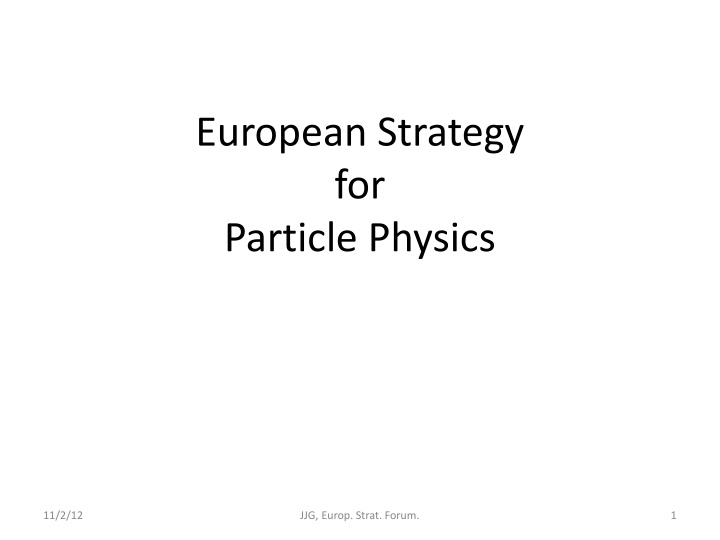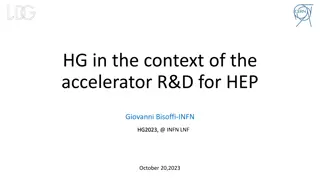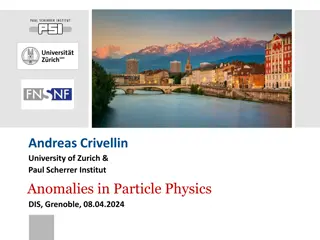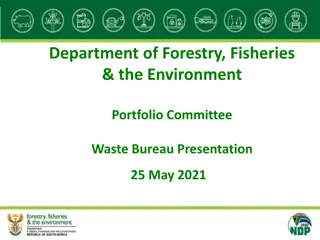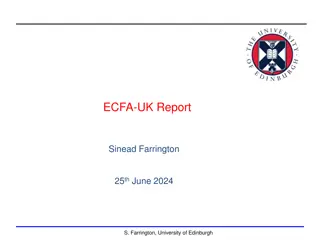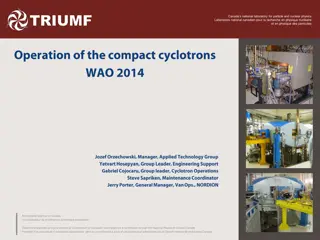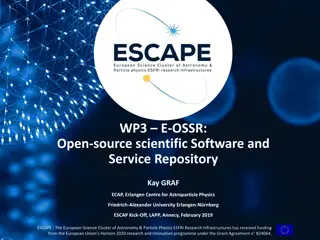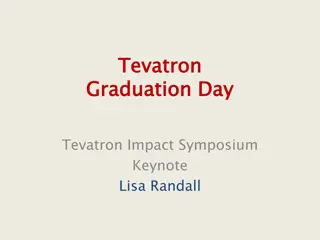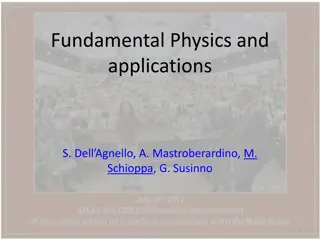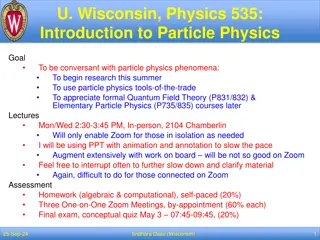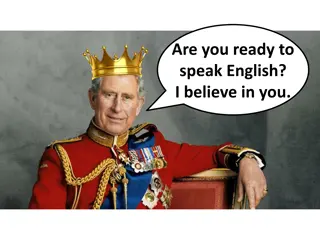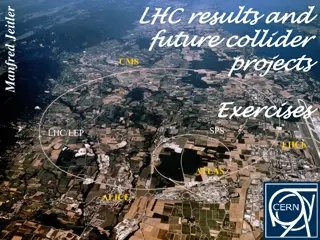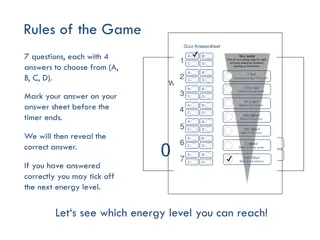European Strategy for Particle Physics Mandate and Composition
The European Strategy for Particle Physics involves the re-enactment process every 5 years to update the medium and long-term strategy, set up a working group, and define the composition of the European Strategy Group. The current strategy, adopted in July 2006, addresses general, scientific, organizational, and complementary issues related to particle physics in Europe.
Download Presentation

Please find below an Image/Link to download the presentation.
The content on the website is provided AS IS for your information and personal use only. It may not be sold, licensed, or shared on other websites without obtaining consent from the author.If you encounter any issues during the download, it is possible that the publisher has removed the file from their server.
You are allowed to download the files provided on this website for personal or commercial use, subject to the condition that they are used lawfully. All files are the property of their respective owners.
The content on the website is provided AS IS for your information and personal use only. It may not be sold, licensed, or shared on other websites without obtaining consent from the author.
E N D
Presentation Transcript
European Strategy for Particle Physics 11/2/12 JJG, Europ. Strat. Forum. 1
Mandate At appropriate intervals, at most every 5 years, the European Strategy Session of Council will re-enact the process aimed at updating the medium and long-term European Strategy for Particle Physics, by setting up a Working Group, the European Strategy Group (ESG), similar to the Strategy Group in 2005/2006. The ESG will be a Working Group of Council which will cease to exist each time Council has adopted the new medium and long-term Strategy. 11/2/12 JJG, Europ. Strat. Forum. 2
Composition The European Strategy Group (ESG) Members Member States Austria Prof. A.H. Hoang Belgium Bulgaria Czech Republic Prof. J. Chyla Denmark Finland France Germany Greece Hungary Italy Netherlands Norway Poland Portugal Slovakia Spain Sweden Switzerland U.K. Invitees The European Strategy Preparatory Group (ESPG) Members Candidate for Accession Romania Associate Member in the pre-stage of Membership Israel Prof. E. Rabinovici Observer States India Prof. T. Aziz Japan Prof. Sh. Asai Russian Fed. Prof. A. Bondar Turkey Prof. Dr M. Zeyrek United States Prof. M. Shochet Prof. W. Van Doninck Prof. L. Litov Dr S. Dita Strategy Secretariat Members Prof. T. Nakada Scientific Secretary (Chair) Prof. J.J. Gaardh je Prof. P. Eerola Prof. E. Aug Prof. S. Bethke Prof. P. Rapidis Prof. P. Levai Prof. F. Ferroni Prof. S. De Jong Prof. A. Read Prof. A. Zalewska Prof. G. Barreira Dr L. Sandor Prof. F. del Aguila Prof. B. Asman Prof. K. Kirch Prof. J. Butterworth Prof. F. Zwirner SPC Chair Dr M. Krammer ECFA Chair Dr Ph. Chomaz Repres. EU Lab. Directors SPC Prof. R. Aleksan (FR) Prof. P. Braun-Munzinger (DE) Prof. M. Diemoz(IT) Prof. D. Wark (UK) EU ApPEC Chair Chair Chair NuPECC Prof. A. Bracco JINR, Dubna Dr R. Lecbychov Dr S. Katsanevas Prof. Y. Osaka ESFRI Dr B. Vierkorn-Rudolph FALC ECFA Prof. K. Desch(DE) Prof. K. Huitu (FI) Prof. A. P. Zarnecki (PL) Prof. C. De Clercq (BE) Prof. V. Matveev CERN Director General Prof. R. Heuer CERN Dr P. Jenni Scientific Assistant Prof. E. Tsesmelis Major European National Laboratories ASIA/AMERICAS Prof. Y. Kuno (Asia) Prof. P. McBride (Americas) CIEMATC. Lopez DESY J. Mnich IRFU Ph. Chomaz LAL A. Stocchi NIKHEF F. Linde LNF U. Dosselli LNGS L. Votano PSI L. Rivkin STFC-RAL J. Womersley 11/2/12 Strategy Secretariat Members Scientific Secretary (Chair)Prof. T. Nakada SPC Chair ECFA Chair Reps. EU Lab. Dir Mtg Dr. Ph. Chomaz Prof. F. Zwirner Dr M. Krammer Prof. E. Tsesmelis Scientific Assistant JJG, Europ. Strat. Forum. 3
REMINDER: European Strategy for Particle Physics Current strategy adopted by the Council in July 2006 17 strategy statements: General issues: Necessity of strategy due to globalization, Europe should maintain its central position in PP 8 Scientific activities LHC, Accelerator R&D, ILC, Neutrino, Astroparticle, Flavour, Nuclear physics, Theory 4 Organizational issues CERN Council s role in coordinating European particle physics Globalization Relation with EU Non-member state relations and role 3 Complementary issues Outreach Technology Transfer Network Relation with industry 11/2/12 JJG, Europ. Strat. Forum. 4
Five working groups 1) Working mode of CERN Council for the European Strategy matters Chaired by M. Spiro 2) Framework for the European participation to a global project and role of national laboratories and CERN Geneva laboratory. Chaired by S. de Jong 3) CERN relation with the European and International bodies such as EU, ESFRI, and others Chaired by B. A sman 4) Knowledge Transfer and iIndustrial relations Chaired by E. Auge 5) Education, Outreach and Communication Chaired by S. Bethke 11/2/12 JJG, Europ. Strat. Forum. 5
European Strategy for PP Timetable Pre-town meetings within disciplines, before summer 2012 General Town Meeting in Krakow, September 10-12, 2012 Briefing book will be written by the Preparatory Group and Scientific Secretaries of the sessions, summarizing the outputs of the symposium. Briefing book will be the scientific input for the Strategy Group for the drafting of the Strategy. Preparation of Strategy drafting session: CERN 11 december Strategy drafting session by the Strategy Group in January 21-26 2013 in ERICE, Sicily. Strategy on scientific and other issues-> Draft for Strategy statements and deliberation document. Draft strategy will be submitted to the CERN Council for the March 2013 session for discussion. Formal adoption of the strategy in a special Council session in Brussels in May 2013 (22 or 23) (coincides with EU council of ministers competitiveness meeting). Outreach event 1 week later? 1) Strategy statement, 2) deliberation document, 3) brochure 11/2/12 JJG, Europ. Strat. Forum. 6
Krakow Town meeting 10-12 September: 2.5 days of session; Close to 500 participants Plenary speakers summarising the current status and future options, with long discussion sessions, for High energy frontier Flavour and symmetries Strong interactions Astroparticle physics Neutrino Theoretical physics Accelerator science Instrumentation, computing, and infrastructure 11/2/12 JJG, Europ. Strat. Forum. 7
Some initial observations/conclusions. Direct-search of new particles at High Energy Frontier and Indirect-search of new physics, i.e. precision measurements at any energy machines to study rare processes looking for a deviation from the Standard Model calculations,are providing fruitful complementary results. But no compelling sign of New Physics so far. Continue pushing at two fronts is essential. Discovery of Higgs like boson at LHC opens a new line of indirect-search: precision measurement of Higgs properties. Is LHC alone enough or a new facility also needed? Linear or Circular e+e colliders, Circular + collider - collider based on circular e storage rings A high energy frontier machine (VLHC etc.) needs more input: from LHC run @ 13~14 TeV e.g. Some of the astropartice projects are addressing particle physics questions: proton decays, , direct search of dark matter, neutrino-less double beta decays A facility for a long baseline neutrino detector share common interests between astropartice physics and particle physics (both accelerator and non- accelerator based) Major challenges in neutrino physics: mass hierarchy, precision measurement of the mixing parameters (in particular the CP violation phase), sterile neutrinos. European neutrino community presented CERN SPS long baseline neutrino beam to Finland with a massive liquid Ar detector for the mass hierarchy and mixing parameter measurements ApPEC joint coordination? CERN SPS short baseline neutrino beam for sterile neutrino search, with exiting detector moving from GSNL to CERN Neutrino factory for ultimate precision measurements of the mixing parameters for a longer term future. USA vision based on cosmology-astropartice programme and long baseline neutrino programme, followed by physics with multi-MW proton driver. JAPAN community pushes 250-500 GeV linear e+e collider with a hope to start data taking before 2030, and Hyper Kamiokande water Cherenkov (or liquid-Ar in Okinoshima) detector for JPARC neutrino beam with a hope to start construction in ~2018, while SuperKEKB construction is in progress. Upgrade of ALICE and with a plan to run till 2026 is the highest priority of the European Heavy Ion community. 11/2/12 JJG, Europ. Strat. Forum. 8
